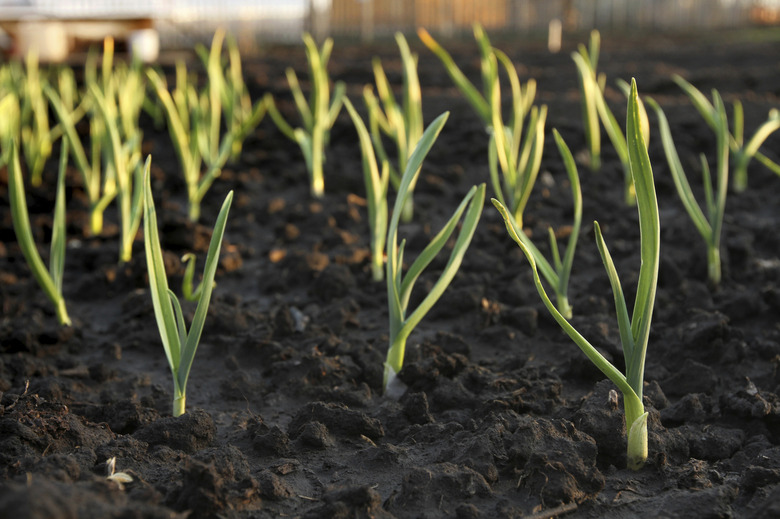My Garlic Is Sprouting: Can I Plant It?
Garlic (Allium sativum) sprouts when it's ready to grow into a new plant. Store-bought garlic cloves sometimes sprout in the refrigerator, and cloves supplied for growing can sprout in storage.
Garlic (Allium sativum) sprouts when it's ready to grow into a new plant. Store-bought garlic cloves sometimes sprout in the refrigerator, and cloves supplied for growing can sprout in storage. There's nothing wrong with sprouting garlic, but store-bought cloves can carry diseases and may not grow well if they aren't suited to local growing conditions. A single garlic clove grows into a garlic bulb in good growing conditions. Garlic is hardy in U.S. Department of Agriculture plant hardiness zones 4 through 9, and it's usually grown as an annual plant.
Fall or Spring Planting
Fall planting provides the largest garlic bulbs, but you can also plant sprouting garlic in spring. Garlic grows best when it receives a period of chilling at temperatures below 65 degrees Fahrenheit. Cloves planted in spring sometimes don't form bulbs.
- Garlic (Allium sativum) sprouts when it's ready to grow into a new plant.
- There's nothing wrong with sprouting garlic, but store-bought cloves can carry diseases and may not grow well if they aren't suited to local growing conditions.
- A single garlic clove grows into a garlic bulb in good growing conditions.
In USDA zones 4 through 9, plant sprouting garlic in fall after the first frost but before the ground freezes. If the area rarely experiences frosts, plant garlic when deciduous trees are bare. In colder zones, plant garlic in spring as soon as the ground thaws. You can also try planting garlic in fall in colder zones. Cover the planting site with a 6-inch layer of straw, spread burlap over the straw and weigh the burlap down with stones. With this protection, the cloves may survive over winter.
Planting Sites
Garlic grows best in well-drained, medium-moisture soils rich in organic matter, and full-sun sites. Loosening the soil helps improve drainage.
- In USDA zones 4 through 9, plant sprouting garlic in fall after the first frost but before the ground freezes.
- With this protection, the cloves may survive over winter.
Prepare the garlic planting site by loosening the soil to a depth of 12 to 15 inches with a garden fork. If the soil is poor or average, spread a 3-inch layer of rich garden compost or well-rotted manure over the soil surface and mix the organic matter into the soil to a depth of 6 inches with a garden fork.
Planting Hole
When planting sprouting garlic, it's important to avoid damaging the sprouts. Dig holes 2 inches deep with a trowel. The planting holes should be 4 to 6 inches apart in rows 15 to 24 inches apart.
Drop the sprouting garlic cloves into the holes sprouts upward. Lightly press the soil over the cloves with your fingertips to close the holes. The sprouts may protrude from the holes, but this isn't a problem. Water the planting area using a soft spray attachment on a garden hose or fine rose on a watering can until water begins to puddle on the soil surface.
- Prepare the garlic planting site by loosening the soil to a depth of 12 to 15 inches with a garden fork.
- If the soil is poor or average, spread a 3-inch layer of rich garden compost or well-rotted manure over the soil surface and mix the organic matter into the soil to a depth of 6 inches with a garden fork.
After Care
Mulching sprouting garlic helps protect sprouts from frost. In warm zones, mulches also help conserve soil moisture. Spread a layer of leaf mold, shredded bark or other loose mulch in a layer 4 inches thick over the garlic cloves. If the sprouts are above the soil, spread the mulch gently to avoid damaging them.
Sprouting garlic needs little water until the sprouts begin growing, which in most zones is usually when the weather warms up in spring. When new growth appears, or if the soil surface beneath the mulch becomes dry, water the garlic until water begins to puddle.
